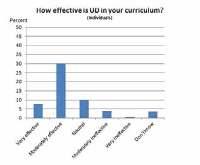Universal Design in Architectural Education: Who is Doing It? How is It Being Done?

Many designers, advocates, and anyone interested in making physical and visual environments more usable for people with diverse backgrounds and abilities have adopted the philosophy known as universal design (UD), inclusive design, or design for all. In an effort to gain a better understanding of the current state of UD content in architecture curricula, researchers distributed an online survey to architectural educators and administrators in 120 U.S. institutions with accredited degree programs. The study consisted of qualitative and quantitative questions that sought information related to the understanding, attitudes, and incorporation of UD into each participant’s curriculum.
Responses were obtained from 463 participants representing 104 of the 120 surveyed schools. Quantitative analyses found relationships between perceived attitudes of administrators, faculty, and students and the effectiveness of UD components in a program. Qualitative findings were rich and complex, revealing great variability across schools in terms of how, when (course level), and the degree to which UD aspects were incorporated into programs. Implications for educational programs, as well as future research, are discussed.
keywords: Inclusive Design, Universal Design, Design Education, Survey Research, Design Curriculum


Add comment
Log in to post comments